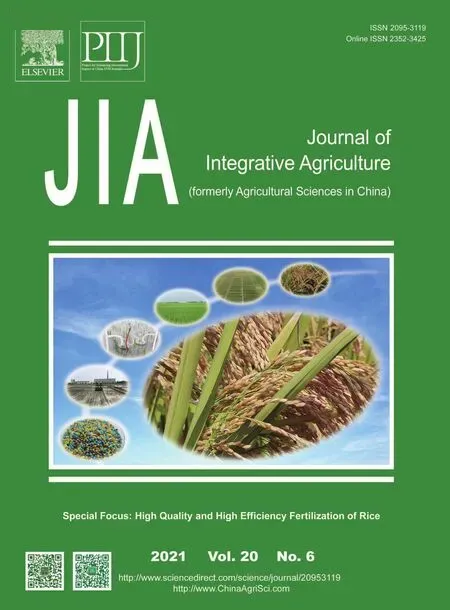The water-saving potential of using micro-sprinkling irrigation for winter wheat production on the North China Plain
2021-05-23ZHAILichaoLihuaDONGZhiqiangZHANGLihuaZHANGJingtingJIAXiulingZHANGZhengbin
ZHAI Li-chao,LÜ Li-hua,DONG Zhi-qiang,ZHANG Li-hua,ZHANG Jing-ting,JIA Xiu-ling,ZHANG Zheng-bin
1 Institute of Cereal and Oil Crops,Hebei Academy of Agriculture and Forestry Sciences/Scientific Observing and Experimental Station of Crop Cultivation in the North China,Ministry of Agriculture and Rural Affairs,Shijiazhuang 050035,P.R.China
2 Center for Agricultural Resources Research,Institute of Genetics and Development Biology,Chinese Academy of Sciences,Shijiazhuang 050021,P.R.China
Abstract The shortage of groundwater resources is a considerable challenge for winter wheat production on the North China Plain.Water-saving technologies and procedures are thus urgently required. To determine the water-saving potential of using micro-sprinkling irrigation (MSI) for winter wheat production,field experiments were conducted from 2012 to 2015. Compared to traditional flooding irrigation (TFI),micro-sprinkling thrice with 90 mm water (MSI1) and micro-sprinkling four times with 120 mm water (MSI2) increased the water use efficiency by 22.5 and 16.2%,respectively,while reducing evapotranspiration by 17.6 and 10.8%. Regardless of the rainfall pattern,MSI (i.e.,MSI1 or MSI2) either stabilized or significantly increased the grain yield,while reducing irrigation water volumes by 20–40%,compared to TFI. Applying the same volumes of irrigation water,MSI (i.e.,MSI3,micro-sprinkling five times with 150 mm water) increased the grain yield and water use efficiency of winter wheat by 4.6 and 11.7%,respectively,compared to TFI. Because MSI could supply irrigation water more frequently in smaller amounts each time,it reduced soil layer compaction,and may have also resulted in a soil water deficit that promoted the spread of roots into the deep soil layer,which is beneficial to photosynthetic production in the critical period. In conclusion,MSI1 or MSI2 either stabilized or significantly increased grain yield while reducing irrigation water volumes by 20–40% compared to TFI,and should provide water-saving technological support in winter wheat production for smallholders on the North China Plain.
Keywords:winter wheat,grain yield,water use efficiency,micro-sprinkling irrigation,traditional flooding irrigation,watersaving potential
1.Introduction
The North China Plain (NCP) is one of the most important agricultural regions in China. It occupies 25% of the total Chinese cultivated land area and supplies approximately 71% of national wheat grain production (NBSC 2015). Winter wheat production generally consumesca.400–500 mm of water over the whole growth period. However,most precipitation falls during the summer maize growing season,with onlyca.20–30% falling in the winter wheat growing period. Rainfall meets only 25–40% of the water requirements of winter wheat (Liuet al.2001). To provide an adequate water supply and achieve high winter wheat grain yields,flood irrigation is commonly applied three or four times during the growth period;this procedure usesca.300 mm of water (Sunet al.2011;Liet al.2012). However,the water use efficiency (WUE) of this form of irrigation is low.Water resources have become scarce in recent years due to the over-exploitation of groundwater for irrigation (Liet al.2010). Thus,the development of water-saving agricultural procedures for the NCP is urgently required.
Various water-saving mechanisms have been used in agricultural production in recent years to improve the WUE of winter wheat (Wang Det al.2013;Manet al.2014c;Aliet al.2018;Zhouet al.2018;Zhaoet al.2020). For example,Xuet al.(2018) proposed that when soil moisture conditions are adequate prior to sowing,two surface irrigations amounting to 150 mm of water at the jointing and anthesis stages would be optimal for wheat production,with a grain yield of 9 267.6 kg ha–1and WUE of 20.2 kg ha–1mm–1. Xuet al.(2016) also found that a moderate water deficit with a total irrigation amount of 60 mm during the non-critical period of wheat can significantly improve irrigation WUE by adjusting the wheat population structure. However,these studies were conducted using surface flooding irrigation,and it would be difficult to improve the water-saving potential of this traditional procedure any further.
Accordingly,new irrigation methods,such as drip irrigation and sprinkler irrigation,have been applied to field crops. These procedures have significantly increased the WUE,especially in areas where water is scarce (Lamm and Trooien 2003;Liuet al.2011;Manet al.2014;Wanget al.2015;AI-Ghobari and Dewidar 2018;Mostafaet al.2018;Suiet al.2018;Caiet al.2020). Daret al.(2017)reported that appropriate timing and depth of drip irrigation increased crop WUE compared to using flooding irrigation.Xue and Ren (2016) also reported that compared to surface flooding irrigation,sprinkler application increased the water productivity of spring wheat and spring maize by 7.9 and 5.0%,respectively. Many previous studies have also found that micro-sprinkling irrigation (MSI) can increase the WUE and grain yield of wheat by 4.6–22.2% and 10.0–27.8%,respectively (Bandyopadhyayet al.2010;Liuet al.2013;Wang Jet al.2013). With the same amount of irrigation,MSI increased the grain yield and WUE of winter wheat by 4.6–22.2% and 10.0–27.8%,respectively,compared to traditional flooding irrigation (TFI) (Liet al.2018,2019).MSI is a new water-saving technology that was conceivedviafurther development of the drip and sprinkler irrigation methods used on the NCP (Manet al.2014). MSI has been used in the field recently,but it has not been widely promoted among most smallholder farmers. Studies have shown that MSI greatly improves irrigation uniformity when applied with optimal sprinkling angles and hose lengths,thereby improving winter wheat yield and WUE (Manet al.2014a,b). Because irrigation with micro-sprinkling hoses has all the advantages of both drip and sprinkler irrigation processes (Manet al.2014a),we predict that MSI will have a leading role in the development of water-saving agricultural techniques on the NCP.
Although previous studies have confirmed that MSI increased the WUE and grain yield of winter wheat in the NCP (Liet al.2018,2019),these studies involved usage of the same amount of irrigation water (120 or 150 mm). There is little information on whether the irrigation water could be further reduced by using MSI or whether the water-saving potential could be improved in winter wheat production. To clarify these issues,we undertook a 3-year field experiment to explore the effect of MSI on winter wheat grain yield and WUE,and to determine the optimal irrigation mode and its water-saving potential for winter wheat grown using MSI.
2.Materials and methods
2.1.Experimental site and meteorological conditions
We conducted field experiments during the following growing seasons:2012–2013,2013–2014,and 2014–2015.The study site was located at the Dishang Experimental Station,Institute of Cereal and Oil Crops,Hebei Academy of Agricultural and Forestry Sciences,Gaocheng County,Hebei Province,China (37°95´N,114°71´E). The location is semi-arid and has a monsoonal climate. The mean annual air temperature at the experimental station was 12.8°C,the mean annual precipitation was 484 mm (rainfall plus snowfall),and the mean annual frost-free period was 144 days. The primary substratum of the area was meadow cinnamon soil,and the soil nutrients in the upper 0–20 cm soil profile comprised organic matter 15.68 g kg–1,total N 1.04 g kg–1,available N 80 mg kg-1,available P 21.4 mg kg-1,and available K 113.9 mg kg-1. Fig.1 shows the daily precipitation and mean air temperature data during the growth and development of winter wheat in the three growing seasons. These data were obtained from the China Meteorological Data Service Center. The total rainfall during the 2012–2013 and 2014–2015 growing seasons was 138.4 and 137.8 mm,respectively,which is a normal level. However,the 2013–2014 growing season was a drought year with a total rainfall of 67.6 mm. The mean air temperature during the 2012–2013 growing season was lower than mean temperatures during the 2013–2014 and 2014–2015 growing seasons.
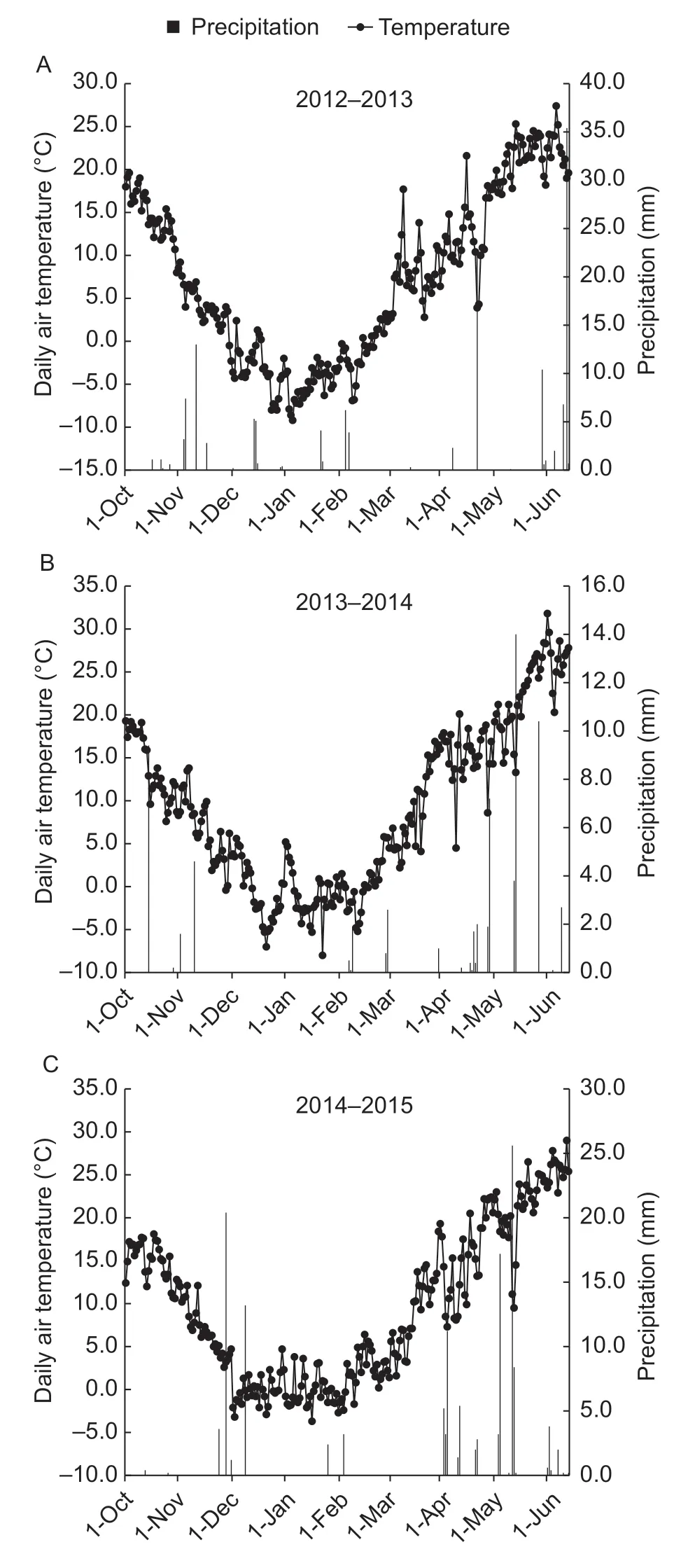
Fig.1 Daily precipitation and mean air temperatures during the 2012–2013 (A),2013–2014 (B),and 2014–2015 (C) winter wheat growing seasons.
2.2.Experimental design
Jimai 585 is one of the most widely-grown winter wheat varieties on the NCP in recent years. We selected this variety for our field experiments. Wheat seeds were sown under adequate soil moisture conditions on 7 October 2012,8 October 2013,and 9 October 2014. The wheat planting density was 360×104ha–1and the row spacing was 15 cm.Five treatments with three replications were deployed in a randomized block design:TFI (control);MSI applied thrice during each season for a total water input of 90 mm (MSI1);MSI applied four times during each season for a total water input of 120 mm (MSI2);MSI applied five times during each season for a total water input of 150 mm (MSI3);and MSI applied six times during each season for a total water input of 180 mm (MSI4). Table 1 list the details of the irrigation timing and water quantities used in each treatment. Each plot measured 8 m×10 m (n=3) and plots were spaced 0.5 m apart.
TFI was conducted using soft polyethylene pipes spaced 2.5 m apart. The diameter of the micro-sprinkling hoses was 40 mm,each hose was 30 m long,and the water flow rate was 6.0 m3h-1. The sprinkling angle of the micro-sprinkling hoses was 45–70°,and the distance between the micro-belt layouts was 1.8 m. A frequency conversion cabinet was installed at the mouth of the water well. The water supply pressure was set to 0.1 MPa. The total application rates of nitrogen (N),phosphate (P),and potassium (K) fertilizers were identical across treatments. Compound fertilizers comprising 19,21,and 5% N,P2O5,and K2O,respectively,were applied at a rate of 600 kg ha–1as basal fertilizer at sowing. Urea with an N content of 46% was applied at a rate of 270 kg ha–1as top dressing. N fertilizer was manually top-dressed only once at the jointing stage in the TFI treatment;the fertilizer was dissolved in the soil solution by subsequent flooding irrigation. In the MSI treatments,urea was integrated with water and top-dressed at the jointing and anthesis stages at rates of 189 and 81 kg ha–1,respectively.Diseases,pests,and weeds were well-controlled in all treatments following local field management protocols.
2.3.Data collection
Chlorophyll contentSoil plant analysis development(SPAD) values of the flag leaf,second leaf from the top,and third leaf from the top of each plant were measured using a SPAD-502 meter (Konica Minolta,Tokyo,Japan).Values were taken from the middle of the uppermost fullyexpanded leaves between 10:00 a.m.and 12:00 a.m.at the anthesis and mid-grain filling stages. Six plants per plot were randomly selected for the measurements.
Photosynthetic ratesPhotosynthetic rates were measured using an Li-6400 Portable Photosynthesis System (LICOR Biosciences,Lincoln,NE,USA). Measurements were taken from fully-expanded flag leaves on sunny days between 10:00 a.m.and 11:30 a.m. The carbon dioxide concentration in the leaf chamber was set to 380 μmol mol–1and photosynthetically active radiation was set to1 200 μmol m–2s–1. Measurements were taken from six randomly selected plants in each plot at the anthesis and mid-grain filling stages.

Table 1 Irrigation amounts and timing for the five treatments during the three-year experiment
Root morphological traitsRoot samples were collected using the section root sampling digging method. Root samples were collected from plants in the TFI and MSI3 plots at the mid-grain stage at 20-cm depth intervals within the depth range of 0–60 cm using a root corer with a diameter of 8 cm. We assumed that samples collected in the rows and between adjacent rows of plants were representative of the total root amount in a given soil layer (Zhanget al.2006).Soil and root samples in each layer were placed in separate string mesh bags. The roots in each bag were prepared by washing away the soil and rinsing the roots thoroughly in tap water;organic debris and other materials were removed by decanting the samples. Images of the clean roots were then produced using a Gt-F5201 scanner (Epson,Tokyo,Japan).These root images were analyzed using WinRHIZO Pro Vision 2009c Software (Regent Instruments Inc.,Québec,QC,Canada) to provide root length densities.
Soil compactionSoil compaction was assessed as penetration resistance. Measurements were made at the mid-grain filling stage in the TFI and MSI3 plots. Soil penetration resistance was determined to a depth of 45 cm in 5-cm increments using a hand-held digital cone-tipped penetrometer with a diameter of 12.8 mm (Field Scout SC 900 Soil Compaction Meter;Spectrum Technologies,Inc.,Plainfield,IL,USA) at three different locations in each plot.
Dry matter accumulationThe above-ground parts of all physiologically mature plants in two 1-m rows (except for border rows) in each experimental plot were sampled.Samples were separated into leaves,stems,spike bracts,and grain. All plant samples were oven-dried at 75°C until they reached a constant weight for determination of aboveground dry matter accumulation.
Grain yield and yield componentsTo determine the grain yield,spike numbers were manually counted in six 1-m central rows before harvest. The kernel number per spike was determined by counting 30 randomly selected spikes in each plot before harvesting. At plant physiological maturity,a 4-m2area was harvested in each plot to determine grain yield (13% water content). The 1 000-kernel weight (13%water content) was calculated by weighing 1 000 seeds from each yield measurement sample (n=3).
Water consumption and WUEWater consumption (ETa)over the whole growing season was calculated using the following water balance equation (Zhanget al.2011):
ETa=P+I+ΔSWD–R–D+CR
wherePis precipitation (mm),Iis irrigation (mm),ΔSWDis soil water depletion (mm),Ris surface runoff,Dis drainage below the 200-cm soil profile,andCRis the capillary rise into the root zone,which was negligible because the groundwater table was more than 37 m deep at the experimental site.RandDare also considered negligible on the NCP (Gaoet al.2017).
WUE (kg m–3) was calculated using the following equation:

where GY is grain yield (kg ha–1).
Leaf water potential (LWP)The LWP of each flag leaf was measured using a WP4-T water potential meter (Decagon Company Limited,Seattle,WA,USA) at the mid-grain filling stage. Four leaves were selected randomly in each plot for measurement. The main veins of the leaves were excised,and the blades were cut into small sections measuringca.3 mm×3 mm. Sections were combined for measurements of leaf osmotic potentials.
2.4.Economic analysis
A partial budget approach was used to perform an economic analysis of winter wheat production with the different irrigation treatments. To express economic concepts,the following terms are abbreviated:fixed costs (FC),net income(NI),total cost (TC),total return (TR),and variable costs(VC). For simplicity,we assume that the main objective of a wheat grower was to maximize the net income (NI) derived from their crop. The NI was calculated as:
NI=TR–(FC+VC)
where TR is the sale revenue of winter wheat grain (wheat grain price,0.34 USD kg–1);FC included seed (110 USD ha–1),fertilizer (428 USD ha–1),herbicide and pesticide(47.2 USD ha–1),and machinery (214 USD ha–1) costs;and VC included labor (22.8–45.7 USD ha–1),MSI equipment(0–142.8 USD ha–1),and water and electricity (51–100 USD ha–1) costs.
2.5.Statistical analyses
Data were compared among treatments with analysis of variance (ANOVA) using SPSS ver.19.0 (SPSS,Chicago,IL,USA). Graphs were plotted with either SigmaPlot ver.12.0 (Systat Software,San Jose,CA,USA) or Excel 2010(Microsoft,Redmond,WA,USA). Results from Shapiro-Wilk tests (Shapiro and Wilk 1965) indicated that all parameters were normally distributed. We tested for homogeneity of variance using the Levene’s test and appropriate transformations were applied to response variables that were heteroscedastic. Back-transformed data for these variables are reported in this paper. Means of treatments were compared using post hoc Turkey’s honestly significant difference (HSD) tests atP<0.05.
3.Results
3.1.Grain yield and yield components
As shown in Table 2,the difference in grain yield among treatments was not significant in the 2012–3013 growing season,while significant differences were observed among treatments in the 2013–2014 and 2014–2015 growing seasons. In the 2013–2014 growing season,the grain yields of MSI2 and MSI3 were significantly higher than that of TFI.In the 2014–2015 growing season,MSI1,MSI2,MSI3,and MSI4 treatments increased grain yields by 6.98,8.24,11.5,and 8.99%,respectively,compared to the TFI treatment.The differences in spike number among treatments were generally not significant in the 2012–2013 and 2014–2015 growing seasons,but they were significantly lower in all MSI treatmentsvs.TFI. MSI tended to increase the kernels per spike,and the kernels per spike of MSI3 and MSI4 were usually significantly higher than that of TFI. The differences in thousand-kernel weight among treatments were mostly not significant,but MSI1,MSI2,and MSI3 significantly increased the thousand-kernel weight,compared to TFI. Higher grain yields in MSI treatments were possibly associated with the increases in kernel number per spike.Moreover,the grain yield was significantly influenced by year and the interaction between year and irrigation.
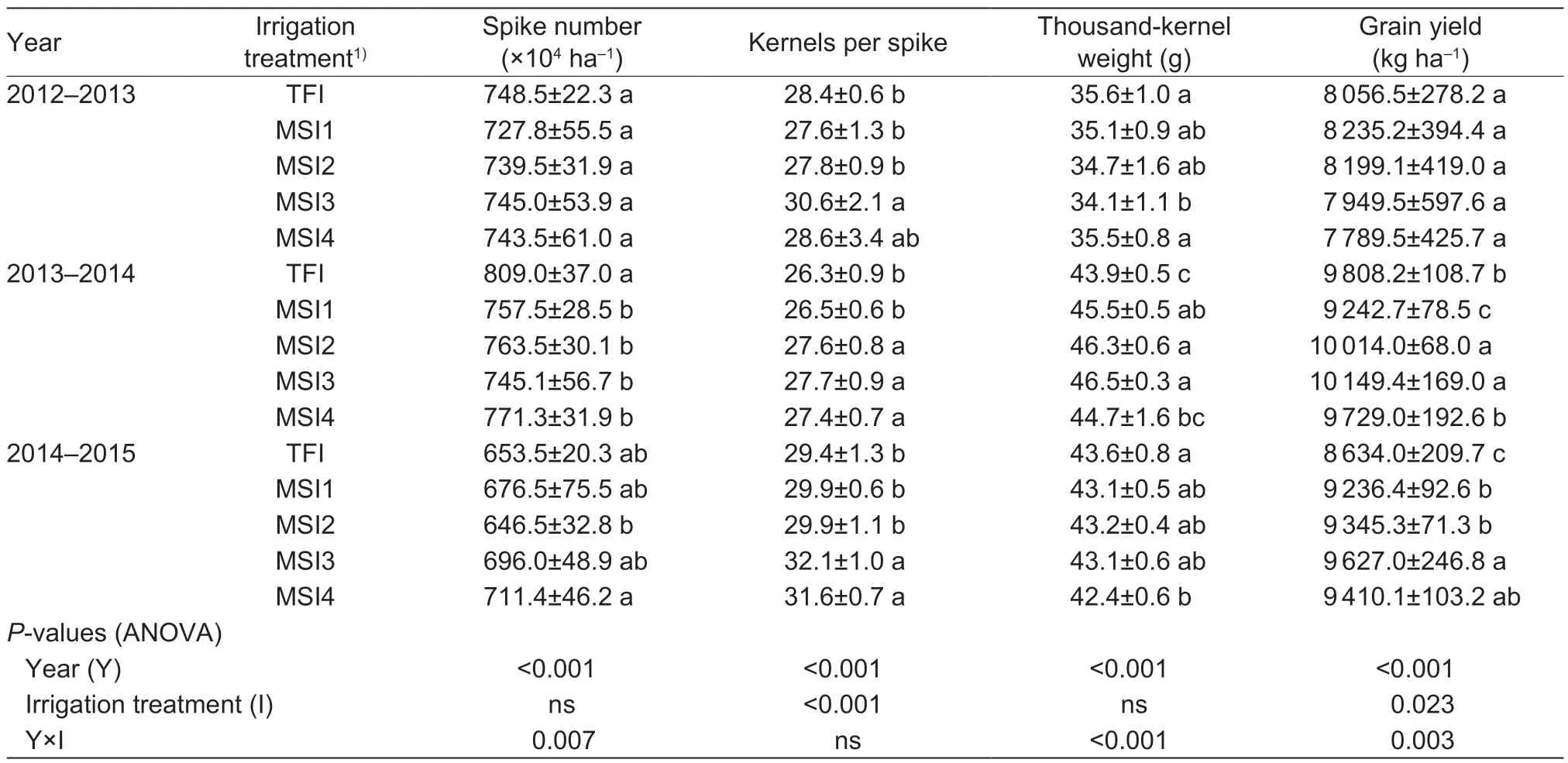
Table 2 Effects of MSI on grain yield and grain yield components
3.2.Crop ET and WUE
The ET and WUE of growing winter wheat under the different irrigation regimes during the three growing seasons are presented in Fig.2. In the 2012–2013 growing season,ET and WUE were not significantly different among the TFI,MSI3,and MSI4 treatments. MSI1 and MSI2 crops exhibited lower ET values than TFI crops. The WUE of MSI1 and MSI2 crops increased significantly by 22.6 and 15.9%,respectively,compared to that of TFI crops. In the 2013–2014 and 2014–2015 growing seasons,ET and WUE did not differ between the TF1 and MSI4 treatments.However,ET values obtained in the MSI1,MSI2,and MSI3 treatments were significantly lower than that obtained in the TF1 treatment. Conversely,WUE was significantly better in the MSI1,MSI2,and MSI3 treatments than in the TFI treatment. WUE in the MSI1,MSI2,and MSI3 treatments increased by 26.4,11.3,and 11.0%,respectively,in the 2013–2014 growing season,and by 15.6,21.3,and 21.0%,respectively,in the 2014–2015 growing season,compared to the TFI treatment.
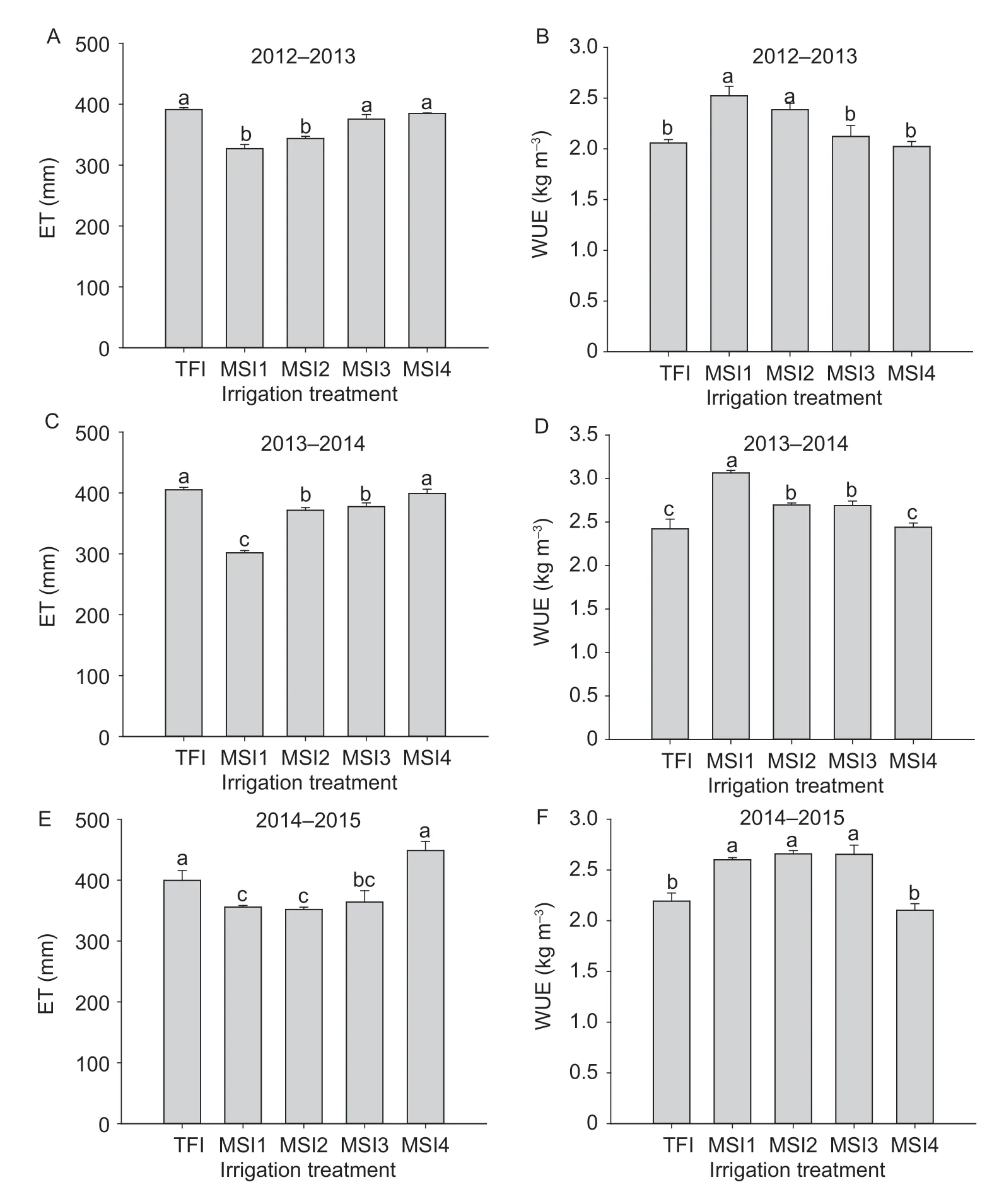
Fig.2 Evapotranspiration (ET) and water use efficiency (WUE) of winter wheat in different irrigation treatments. TFI,traditional flooding irrigation;MSI,micro-sprinkling irrigation;MSI1,MSI applied thrice during each season for a total water input of 90 mm;MSI2,MSI applied four times during each season for a total water input of 120 mm;MSI3,MSI applied five times during each season for a total water input of 150 mm;MSI4,MSI applied six times during each season for a total water input of 180 mm. Data are presented as mean+SE (n=3). Different lowercase letters indicate significant pairwise differences (P<0.05) between means within each plot (Tukey’s HSD test).
3.3.Leaf area index (LAI),dry matter accumulation(DMA),and harvest index (HI)
The maximum leaf area index (LAImax) of MSI1 was significantly lower than those of the other treatments,while the LAImaxof MSI2,MSI3,and MSI4 were higher than that of TFI in the 2014–2015 growing season (Table 3). The differences in DMA among treatments were usually not significant in the 2012–2013 and 2013–2014 growing seasons. However,MSI treatments significantly increased the DMA in the 2014–2015 growing season compared to TFI. The differences in HI between MSI treatments and TFI were usually not obvious in the 2012–2013 and 2014–2015 growing seasons,but they were significantly lower than that of TFI in the 2013–2014 growing season. The irrigation effect and year×irrigation interactive effect on LAImax,DMA,and HI were all significant.
3.4.Chlorophyll content (SPAD values)
As shown in Table 4,compared with TFI,MSI treatments usually increased the chlorophyll content of flag leaves at anthesis and the mid-grain filling stage during the 2013–2014 and 2014–2015 growing seasons. For the second and third leaf from the top,MSI1 and MSI2 usually increased the chlorophyll content compared to TFI. A significant year effect was observed for all leaves,and the irrigation and year×irrigation interactive effects were significant for the second and third leaves from the top.
3.5.Photosynthetic rate
Photosynthetic rate is important for biomass formation and grain yield,and Fig.3 shows the effect of MSI treatments on the net photosynthetic rates of flag leaves. In the 2012–2013 growing season,the net photosynthetic rates of flag leaves at the anthesis and mid-grain filling stages in the MSI1,MSI2,and MSI3 treatments were higher than those observed in the TFI treatment;and the differences were significant for the MSI1 and MSI2 treatments. In the 2013–2014 growing season,photosynthetic rates at anthesis did not differ significantly between the TFI and MSI1 treatments,but photosynthetic rates were significantly higher for leaves in the MSI2,MSI3,and MSI4 treatments.Similarly,photosynthetic rates of leaves at the mid-grain filling stage in the MSI2,MSI3,and MSI4 treatments were significantly higher than those observed in the TFI treatment.In the 2014–2015 growing season,the photosynthetic rates of leaves at anthesis in each of the MSI treatments exceeded those in the TFI treatment;and the differences were significant for the MSI2 and MSI4 treatments. However,at the mid-grain filling stage,the photosynthetic rates of leaves in MSI1 and MSI2 were significantly lower than those observed in the TFI treatment.
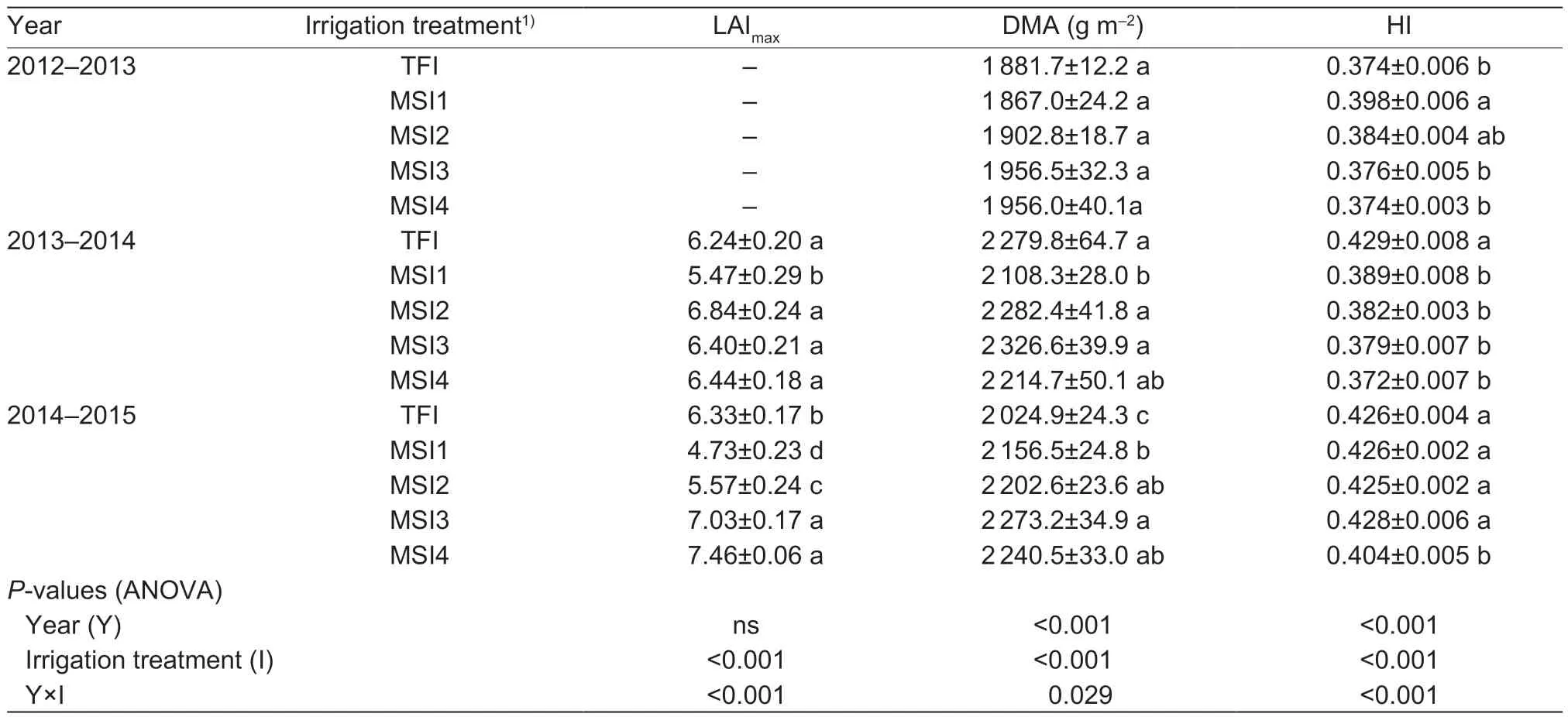
Table 3 Effects of micro-sprinkling irrigation on maximum leaf area index (LAImax ),total dry matter accumulation (DMA),and harvest index (HI) of winter wheat
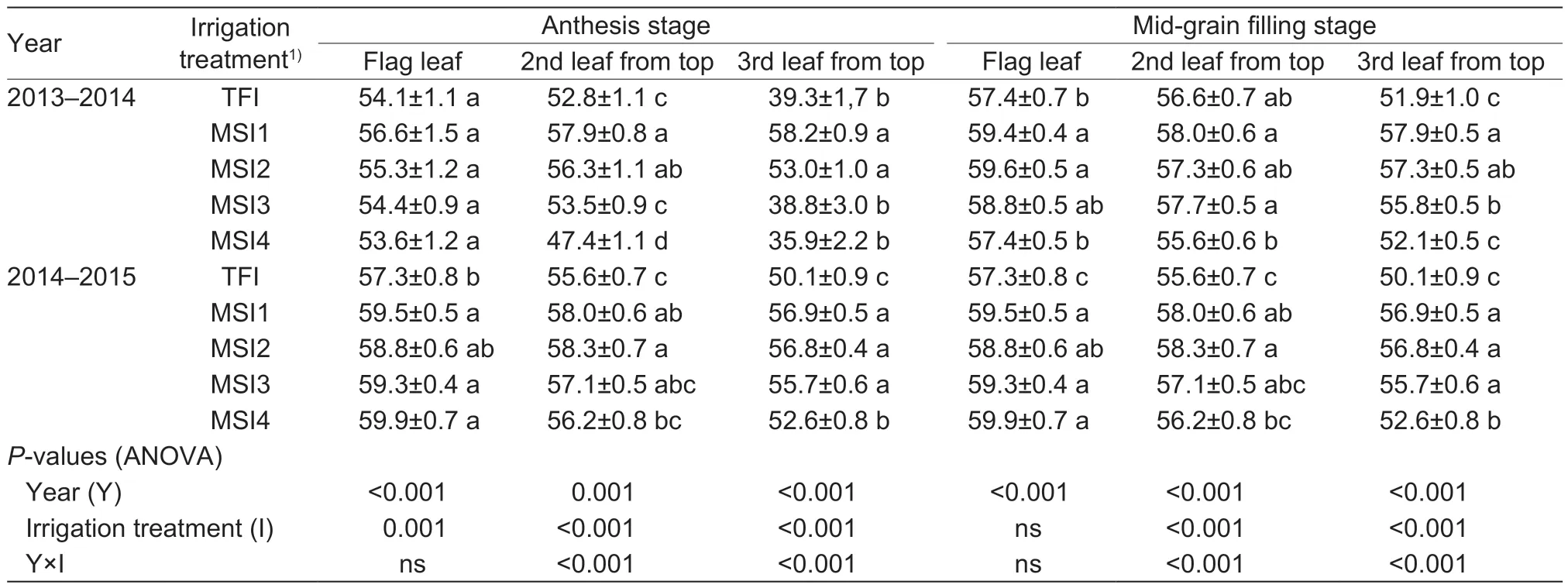
Table 4 Effect of micro-sprinkling irrigation on leaf chlorophyll content
3.6.LWP
LWP values reflect the water condition of crops. The winter wheat LWPs at the mid-grain filling stage for different irrigation treatments are displayed in Fig.4. In the 2013–2014 and 2014–2015 growing seasons,MSI crops usually exhibited significant higher LWPs than TFI crops.In the 2013–2014 growing season,MSI4 crops exhibited the highest LWPs,followed by MSI2,MSI3,MSI1,and TFI crops. In the 2014–2015 growing season,MSI4 crops exhibited the highest LWPs again,followed by MSI3,MSI2,MSI1,and TFI crops.
3.7.Soil compaction and root morphological traits
Values of soil compaction to a depth of 450 mm in MSI and TFI plots are displayed in Fig.5. In the 2013–2014 growing season,MSI plots exhibited less soil compaction from depths of 5 to 45 cm. The mean soil compaction was 20.5% less in MSI plots compared to TFI plots. In the 2014–2015 growing season,MSI plots had 11.2% less soil compaction on average,compared to the TFI plots.
Root growth influences nutrient and water absorption by plants,and hence crop growth and yield. In this study,MSI affected root DMA and morphological traits (Fig.6).MSI3 plants produced significantly less root DMA and exhibited significantly lower root length density in the 0–20 cm soil layer compared to TFI plants. However,MSI3 plants produced significantly more root DMA and exhibited significantly higher root length density in the 20–100 cm soil layer. Furthermore,MSI3 plants exhibited significantly larger root diameters and root surface areas in the 0–100 cm soil layer compared to TFI plants. The mean root diameter and surface area were larger by 6.3 and 47.5%,respectively.
3.8.Economic benefits
The economic benefit analysis of different irrigation treatments was based on the average input and output of winter wheat production during the three growing seasons.Compared to TFI,MSI1,MSI2,MSI3,and MSI4 decreased the net benefits by 73.6,49.9,65.0,and 133.1 USD ha–1,respectively (Table 5);this was mainly due to the increased total cost of MSI. However,MSI1 and MSI2 reduced the irrigation water amount by 60 and 30 mm,respectively,which has major social and ecological benefits in this region.
4.Discussion
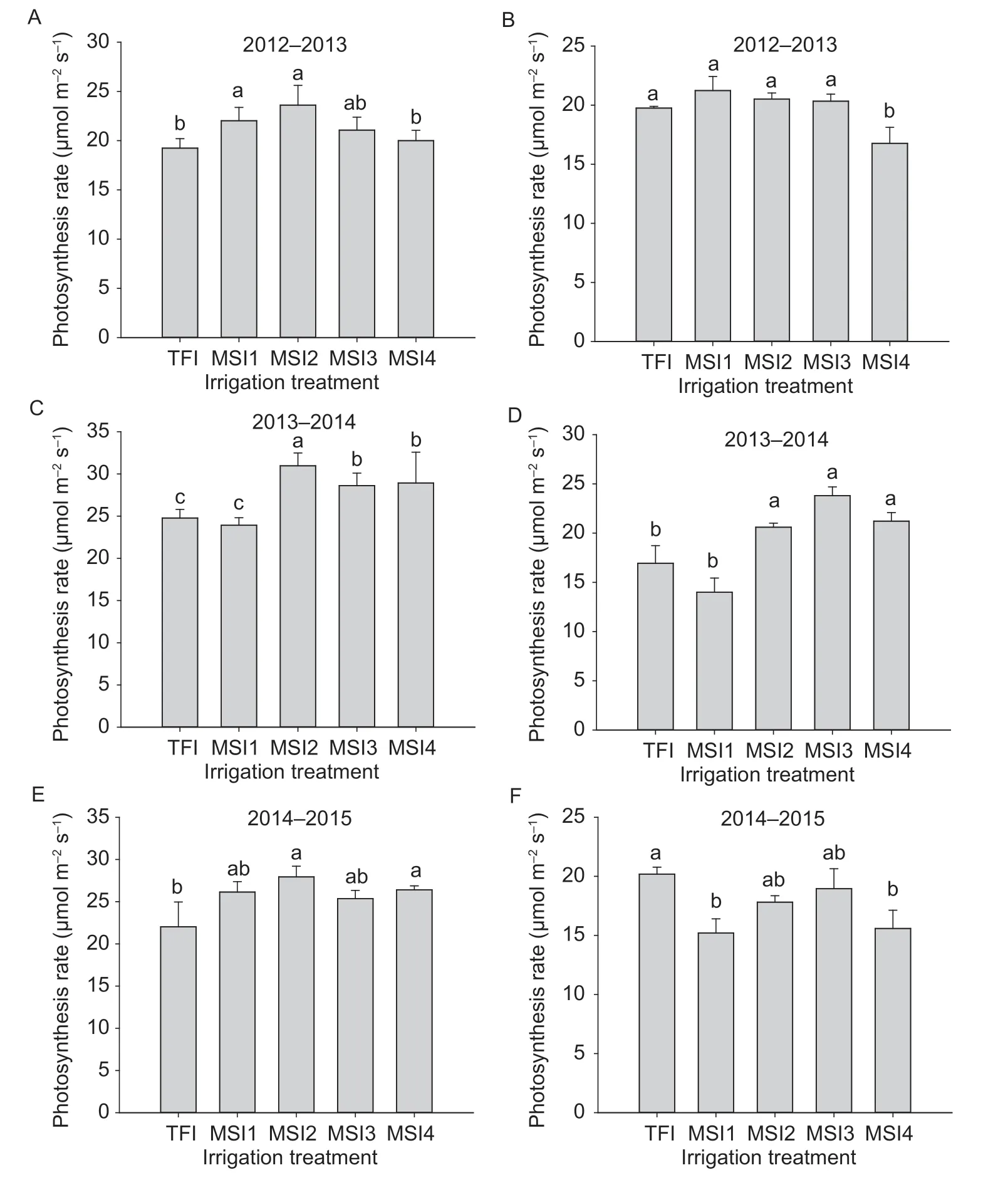
Fig.3 Effect of micro-sprinkling irrigation on the net photosynthetic rate of winter wheat. TFI,traditional flooding irrigation;MSI,micro-sprinkling irrigation;MSI1,MSI applied thrice during each season for a total water input of 90 mm;MSI2,MSI applied four times during each season for a total water input of 120 mm;MSI3,MSI applied five times during each season for a total water input of 150 mm;MSI4,MSI applied six times during each season for a total water input of 180 mm. A,C and E,at flowering stage. B,D and F,at mid-grain filling stage. Data are presented as mean+SE (n=3). Different lowercase letters above the columns indicate significant differences (P<0.05) between treatments (Tukey’s HSD test).
The NCP is a water-limited region that is used extensively for winter wheat production. Winter wheat is a major groundwater-consuming cereal crop,and TFI is therefore widely used to maintain production (Liuet al.2013).This procedure often involves two or more applications that supply an excess of irrigation water,which makes improvements in WUE and sustainable development of agriculture difficult to achieve. Hence,optimized watersaving measures and irrigation regimes for higher WUE and grain yield have been explored in the past. Irrigating crops twice (at jointing and anthesis) with a total of 150 mm of irrigation water has been identified as an optimized irrigation regime (Xuet al.2018;Zhouet al.2018;Zhanget al.2019).However,current water-saving irrigation procedures based on flooding methods continue to lower the groundwater table and have serious impacts on sustainable development(Sunet al.2010;Yanget al.2010). With flooding irrigation,it is difficult to further improve the water-saving potential.New highly efficient water-saving technologies are required instead. In recent years,MSI has become popular for field crop production as it is more efficient than TFI (Liuet al.2011;Manet al.2014a,b,2017;Xuet al.2018;Liet al.2018,2019). Liet al.(2018) described an optimized MSI schedule for winter wheat,but they used the same volumes of irrigation water in their TFI and MSI treatments. Thus,the MSI procedure did not save any water.
4.1.Effect of MSI on grain yield
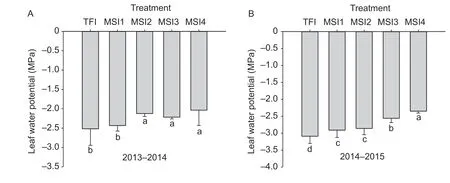
Fig.4 Effect of micro-sprinkling irrigation on the flag leaf water potential of winter wheat at the mid-grain filling stage. TFI,traditional flooding irrigation;MSI,micro-sprinkling irrigation;MSI1,MSI applied thrice during each season for a total water input of 90 mm;MSI2,MSI applied four times during each season for a total water input of 120 mm;MSI3,MSI applied five times during each season for a total water input of 150 mm;MSI4,MSI applied six times during each season for a total water input of 180 mm.Data are presented as mean+SE (n=3). Different lowercase letters indicate significant differences (P<0.05) between treatments(Tukey’s HSD test).
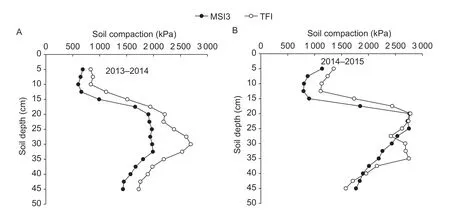
Fig.5 Soil compaction under traditional flooding irrigation and micro-sprinkling irrigation regimes. TFI,traditional flooding irrigation;MSI3,micro-sprinkling irrigation applied five times during each season for a total water input of 150 mm.
We found that the effect of MSI on grain yield differed among years. In the 2012–2013 growing season (a normal rainfall year),there were no significant differences in grain yields among treatments. Hence,the MSI1 and MSI2 treatments produced stable grain yields while reducing irrigation water volumes. Differences in spike number,kernel number per spike,and kernel weight were not obvious among the TFI,MSI1,and MSI2 treatments. In the 2013–2014 growing season (a drought year),the grain yield of MSI1 crops was significantly lower than the yield of TFI crops,largely due to a significant decrease in spike numbers in MSI crops.As we increased the amount of irrigation water,grain yields improved due to increases in kernels per spike and thousand-kernel weights. Compared with TFI crops,MSI3 crops significantly increased their grain yield by 3.47%,suggesting that the frequent application of small volumes of water improved yield under a restricted irrigation protocol as shown in previous studies (Liet al.2018,2019). In the 2014–2015 growing season (a normal rainfall year),the grain yields of crops in all MSI treatments increased significantly.Thus,large grain yields can still be obtained when water volumes are reduced in MSI. The main factor causing the differences in yield among years was the changes in the meteorological condition;to minimize the differences among years,the irrigation regime should be optimized for the meteorological conditions. Generally,elevated leaf photosynthetic rates at the anthesis and grain filling stages are generally closely related to grain yields in winter wheat(Fanet al.2015;Aliet al.2018). We found that elevated leaf SPAD values and photosynthetic rates at the anthesis and mid-grain filling stages in the MSI treatments were associated with improved biomass production,especially in the 2014–2015 growing season (Table 3),which may also explain the significant grain yield increases in all MSI treatments in the 2014–2015 growing season. Thus,increasing plant biomass,especially the post-anthesis biomass,contributes to great improvement in grain yields(Xueet al.2006;Shiet al.2016).
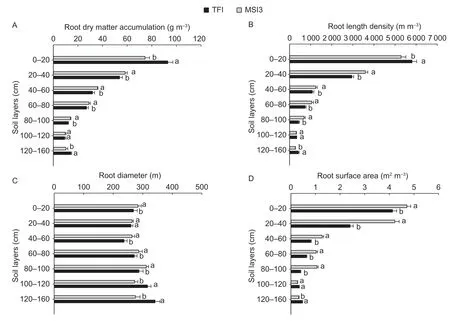
Fig.6 Root dry matter accumulation,length densities,diameters,and surface areas of winter wheat grown under TFI and MSI3 treatments. TFI,traditional flooding irrigation;MSI3,micro-sprinkling irrigation applied five times during each season for a total water input of 150 mm. Data are presented as mean+SE. Different lowercase letters indicate significant differences (P<0.05)between treatment means at each soil layer (Tukey’s HSD test).

Table 5 A partial budget analysis for winter wheat production under different treatments
4.2.Effect of MSI on WUE and water-saving potential
The WUE of cereal crops is mainly determined by grain yield and ET. Previous reports have indicated that the WUE of crops can be improved by reducing ET,and that grain yields can be increased even under restricted irrigation regimes(Igbadunet al.2007;Liet al.2010;Gaoet al.2017;Wang L Let al.2018;Wang Y Qet al.2018).
In the 2012–2013 growing season,MSI1 and MSI2 crops exhibited significantly higher WUE compared to TFI crops. The MSI1 treatment stabilized grain yield with a 40%reduction in irrigation water volume (by 600 m3ha–1). In the 2013–2014 and 2014–2015 growing seasons,MSI1,MSI2,and MSI3 crops exhibited significantly higher WUE than TFI crops,mainly due to reductions in ET (Fig.2). The MSI2 treatment stabilized grain yield in the 2013–2014 growing season with a 20% reduction in irrigation water volume (by 300 m3ha–1). MSI1 crops exhibited significantly higher grain yields (7% increase) in the 2014–2015 growing season with a 40% reduction in irrigation water volume. Crops in the MSI treatments using the same irrigation water volume as TFI treatments exhibited significantly higher grain yields and WUE in the 2013–2014 and 2014–2015 growing seasons,similar to results from previous studies (Liet al.2018,2019). The elevated WUE in MSI treatments may be due to more extensive root systems that developed with frequent applications of small volumes of irrigation water. Optimized irrigation has been reported to regulate wheat root growth,and an appropriate soil water deficit can promote the spread of roots into deep soil layers,further increasing the absorption and use of deep water resources and thereby improving WUE (Lüet al.2015;Xuet al.2016).We found that MSI-treated crops produced significantly more root DMA,and exhibited significantly larger root length densities,diameters,and surface areas in the 20–100 cm soil layer,while using the same irrigation water volume as TFI (Fig.6). This is likely because MSI treatments reduced soil compaction (Fig.5). MSI-treated crops that received less water than TFI crops (i.e.,MSI1 and MSI2 treatments)also exhibited higher LWP than TFI crops (Fig.4),suggesting that MSI treatment may facilitate crop use of subsoil water,which can improve grain yield (Kirkegaardet al.2007).
4.3.Proposal for a water-saving regimen based on MSI for winter wheat production on the NCP
The water-saving potential of MSI for winter wheat production differed among growing seasons in our study.In a normal rainfall year,the MSI1 treatment stabilized grain yield or significantly increased grain yield compared to the TFI treatment while reducing irrigation water volume by 40%. However,in a drought year,the grain yields of MSI1 crops were significantly lower than those of TFI crops. By contrast,the MSI2 treatment stabilized grain yield with a 20%reduction in irrigation water volume. MSI has considerable potential for reducing irrigation water usage by 20–40%compared to TFI deployed in water-saving mode (i.e.,irrigating crops at jointing and anthesis with a total of 150 mm of water). Thus,further reductions in irrigation water volumes are important for additional water savings while using MSI. We therefore propose the following water-saving regimen based on MSI and depending on the rainfall amount a given growing season:
(1) In a normal rainfall year,MSI should be applied thrice(at jointing,anthesis,and grain filling) with 30 mm water on each occasion for a total of 90 mm of irrigation water.
(2) In a drought year,one additional application of 30 mm of irrigation water would be required. The timing of application depends on the rainfall amounts at the different wheat growth stages. In a year with no rainfall at the booting stage,additional irrigation water should be supplied at this stage. If crops experience drought from sowing to the erecting stage,additional irrigation water should be supplied at the erecting stage.
4.4.Evaluation of the application of MSI in winter wheat production in the NCP
MSI can significantly increase the grain yield and WUE of winter wheat (Manet al.2014a;Liet al.2018,2019). It has recently been applied in field production,but it has not been widely promoted among smallholder farmers because most of them believe that MSI will increase their costs. However,farmers often ignore the significant ecological and social effects in the NCP,where water is scarce. Compared to TFI,MSI1 and MSI2 increased the total cost by 85.9 and 110.5 USD ha–1,respectively. The net benefits of MSI1 and MSI2 were also lower than that of TFI. However,MSI1 and MSI2 significantly reduced the amount of irrigation water,which is important to the development of sustainable agricultural on the water-restricted North China Plain. In this study,compared to TFI,MSI1 and MSI2 increased the grain yield of winter wheat while saving 60 and 30 mm of irrigation water,respectively,which contributes to water-saving irrigation in winter wheat production.
5.Conclusion
MSI1,MSI2,and MSI3 treatments led to significantly higher WUE and reduced ET compared to TFI. Higher WUE values were associated with an improved root system. Compared to TFI,MSI1 and MSI2 stabilized or significantly increased grain yield with a 20–40% reduction in irrigation water volume depending on the rainfall pattern in that year. These results could enable water-saving technological support for smallholders in winter wheat production,and are of great importance to sustainable agricultural production.
Acknowledgements
This study was supported by the National Key Research and Development Program of China (2017YFD0300203 and 2016YFD0300105).
Declaration of competing interest
The authors declare that they have no conflict of interest.
杂志排行
Journal of Integrative Agriculture的其它文章
- Low glycemic index:The next target for rice production in China?
- Do cooperatives participation and technology adoption improve farmers’ welfare in China? A joint analysis accounting for selection bias
- Impacts of household income on beef at-home consumption:Evidence from urban China
- Changes in bacterial community and abundance of functional genes in paddy soil with cry1Ab transgenic rice
- Synergistic effect of Si and K in improving the growth,ion distribution and partitioning of Lolium perenne L.under saline-alkali stress
- Microbial community dynamics during composting of animal manures contaminated with arsenic,copper,and oxytetracycline
